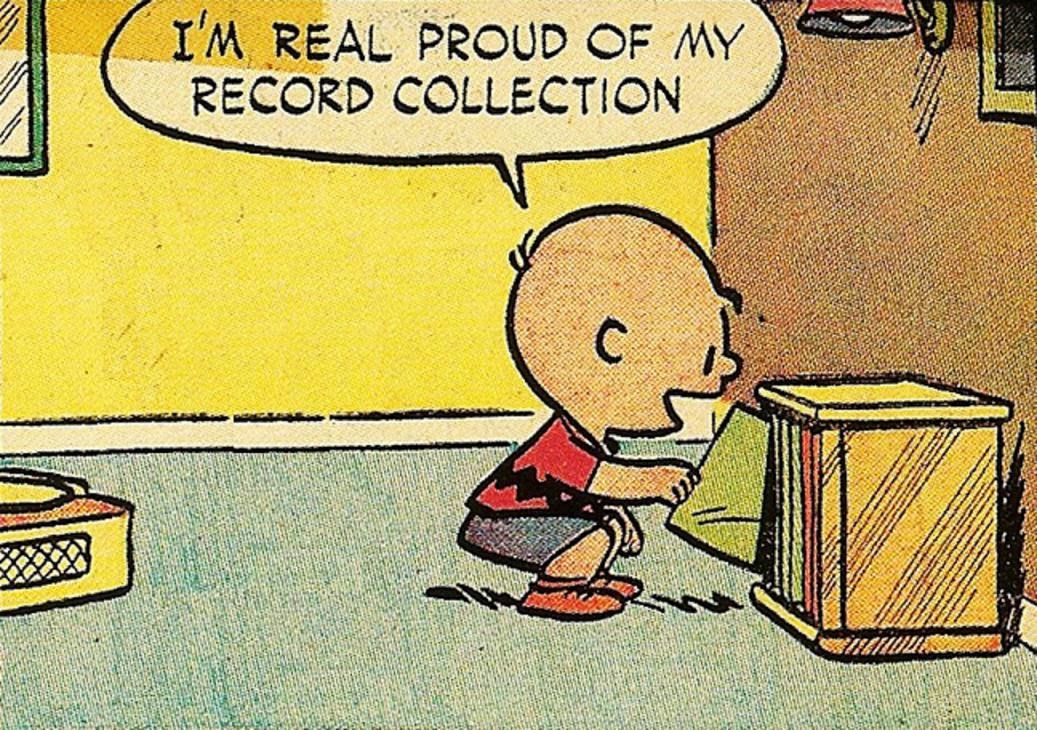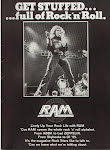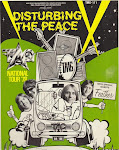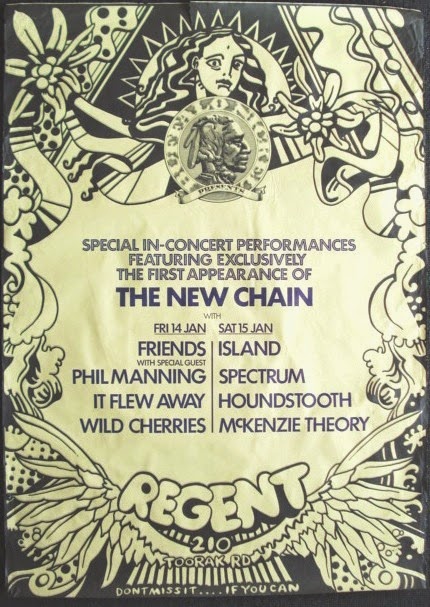Those who grew up in the ’70s listening to Top 40 radio stations like 2SM, 3XY, 6PM and 2NX will remember the annual 'Rocktober' promotion that began in 1974. Those stations were soon followed by 4IP and 2CC.
Rocktober was the brainchild of Jaan Torv (aka John Torv), former creative director of the Digamae programming consultancy that gave those stations their distinctive Top 40 sound. The Rocktober concept has since been copied by stations around the world. Torv’s distinctive voice was heard on the original Rocktober promos heard coast to coast in the ’70s.
During Rocktober, the stations featured live concerts, on-air music specials, and competitions and promotions.
For one in particular: Rocktober 1979, 2SM presented a mega-concert on the steps of the Sydney Opera House called 'The Concert of the Decade'. It featured acts like Stevie Wright, Skyhooks, Richard Clapton, Hush, Dragon, Jim Keays, Jon English, Sherbet, OL’ 55, Ted Mulry Gang, Colleen Hewett, Russell Morris, Billy Thorpe, Brian Cadd, Marcia Hines, Doug Parkinson and Blackfeather.
(I have the Mushroom double album taken from this concert and it is my intention to post it in the near future).
The original official Rocktober stations were: 2SM Sydney, 3XY Melbourne, 4IP Brisbane, 6PM Perth, 2CC Canberra and 2NX Newcastle. Others copied later.
3XY was Melbourne's dominant music radio station during the 1970s and early 1980s with a Top 40 music radio format.
Every week commencing December 24th 1971 until December 31st 1988, they produced their 3XY Music Survey which was available from all major record stores in Victoria. The album featured here was released in 1981 by Mushroom records and 3XY to celebrate 20 years of Australian Rock. Strangely enough, it was subtitled 1981 Volume 1 however I don't think a Volume 2 was ever released.
[by GREG ALLEN-PRETTY October 1, 2023]
Album Liner Notes
In the words of GLENN A.BAKER, Australian Editor for Billboard:
It is now startlingly evident that there was an Australian 'sound' long before there was an Australian music industry sufficiently mature to exploit it fully.
That sound is now something we accept without question as our music regularly penetrates international charts.
But it wasn't always like that; the global acceptance wasn't always so instantly forthcoming. Up until the mid seventies Australian music had to overcome all manner of daunting hurdles from inadequate studios, to inexperienced producers, to poorly paid and often humiliating live bookings, to the great Australian inferiority complex.
Through the many lean periods it seemed that the only friend it had was Australian radio. Certainly there were years when the confidence and support may have been a little strained but, no matter what the prevailing attitude, the cream always rose to the top and that which was worthy of becoming a hit usually did become a hit. Before the world opened its doors, the small, self-contained antipodean rock scene worked hand in hand with commercial radio in this country to bring to our ears works of enduring quality and charm.
In this vast continent we are witnessing a degree of creative endeavor quite disproportionate to our meagre population. Diverse, rich and intelligent, Australian music has affected us all. This album is but a humble sampling of the depth from 20 years.
She's My Baby (1960)
After l0 smash hits beginning in 1958 (when Bill Haley personally recommended that he be given a recording contract with Festival Records), Johnny O'Keefe kicked off the sixties with the first Australian hit of the decade. Released on January 7th, as the first Australian issue on the Lee Gordon label (though it was recorded in Los Angeles), this classic hit streaked to number one, returning to the charts in 1969.
BILLY THORPE AND THE AZTECS
Poison Ivy (1964)
Not only the first Australian 'beat' recording but the first single to break through the very real wall which separated Sydney and Melbourne to become an actual national hit (Melbourne started playing it because they thought the group were from England)
The Aztecs started life as crack instrumental group, The Sierras, with British born Thorpe switching over from amateur yodelling in Queensland. The band's songwriter, Tony Barbos (later Barber) swiped the arrangement from the Rolling Stones' first EP.
She's So Fine (1965)
This second single propelled the dynamic determined Easys from the Villawood migrant hostel, Havana Village, The Bowl and Beatle Village to a degree of unprecedented teen idol status, kicking off a string of eight huge hits within eighteen months. We lost our beloved heroes to England at the end of 1966 but the world gained a rock anthem with "Friday On My Mind". George Young and Harry Vanda endure as the patron saints of Oz rock 'n' roll, later performing as Flash & The Pan.
RAY BROWN AND THE WHISPERS
Fool Fool Fool (1965)
Ray Brown and the Whispers replaced Thorpie as resident band at Sydney's Surf City and Beach House late in 1964. Ray was a young footballing customs clerk who happened to climb up on stage one fateful night. The Whispers had been recording instrumentally for some time as the Nocturnes. The group scored three consecutive number one Sydney hits within four months, an achievement yet to be equaled. This was the third.
Big Time Operator (1967)
Jeff St. John (Jeff Newton) and the Blueswailing ID were Australia's first notable discotheque band resident for most of 1965 at the legendary Here disco in North Sydney. Zoot Money's "Big Time Operator" was the group's fourth single and was broken by the exposure it received when they opened for the Yardbirds, Walker Brothers and Roy Orbison tour around Australia. Jeff remains a highly respected figure in Australian music, with a voice which grows more stunning with the passage of time.
One (1969)
British born Farnham began singing at 16 with Melbourne's, The Mavericks, moving onto Strings Unlimited in 1965. ln 1967, he came to the attention of EMI house producer, David McKay via appearances on the Kommotion TV show and a TAA commercial. By Christmas of that year he had become a household name with the novelty hit "Sadie The Cleaning Lady".
Harry Nilsson's "One" was Johnny's fifth hit, a top five smash in August 1959. Like Jeff his voice gets better as it gets older.
Black And Blue (1971)
Originating in Perth in 1968 as The Beaten Tracks, Chain became leaders of the 'heavy' music movement which challenged the supremacy of commercial pop.
A functional utility name for whatever group the musician's guitarist, Phil Manning had gathered around himself from I968 to 1973, Chain was synonymous with blues of the highest quality and integrity. Chain Mark lll, featuring the raw voice of the Bay City Union's Matt Taylor brought the underground to street level in 1971 when the tortured "Black and Blue" hit #1 in Melbourne.
Boppin' The Blues (1972)
Blackfeather surfaced in 1970 as a highly regarded unit under the control of ace guitarist, John Robinson. They turned heads with the extraordinary "Seasons Of Change" hit in 1971, caped by Neale Johns ethereal voice. Within a few months, Robinson had departed and Neale carried on with a more rock 'n' roll orientated direction. A year later, a radical reworking of Carl Perkins' "Boppin' The Blues", driven along by Paul Wyldes acoustic piano, became a national number one hit, charting for 20 weeks.
Goodbye Lollypop (1973)
Formed in 1971 by students of Melbourne's Swinburne Tech, Madder Lake impressed Sunbury'72 and were one of the very first signings to the new Mushroom Records label in 1973, becoming one of this country's very first album oriented bands. "Goodbye Lollypop" was one of two hits from the gold LP 'Stillpoint'. Leader, Mick Fettes turned up in Bandicoots in 1976, sometime later.
Cassandra ( 1973)
Sherbet are still a yardstick for success in Australian music. Formed in 1969, they racked up 20 consecutive hit singles, 12 albums yielding 10 platinum and 8 gold discs, every possible Australian music award of the 70's and the honour of being not only the biggest domestic record sellers of all time but also the first local act to sell a million dollars worth of records in Australia. Sherbet concerts were always intense and exciting spectacles. Following hot on the heels of "Hound Dog", "Casandra" was a Sherbet classic that maintained their enormity throughout 1973.
Way Out West (1974)
Assembled from the ashes of Country Radio and Axiom, The Dingoes incorporated the country rock leanings of these two outfits into a raunchy rock backdrop.
The self-titled debut album, named best album of the year by the Federation of Australian Broadcasters, yielded the warm and textured "Way Out West", a national hit which was followed by "Boy On The Run".
ln 1976 the band moved base to America at the request of Rolling Stones' stateside manager, Peter Rudge. Their strife ridden stay resulted in just one album, the overlooked 'Five Times The Sun'. The sumptuous lead voice of Broderick Smith has been put to good use of late out front of the Big Combo.
Girls On The Avenue (1975)
Richard began playing with bands in Australia, England and Germany around 1967 but did not record until 1972 when he layed down the sensitive 'Prussian Blue' album for Festival Records. With each successive LP, Richard gained confidence and vision until he was able to deliver the finest east coast surfing album imaginable with 1977's 'Goodbye Tiger'.
"Girls On The Avenue" was an unexpected national number two smash in 1975, a hit which served to swing him toward a slightly harder edge in his music.
Heading ln The Right Direction (1975)
From the early 70's, bluesy Renee fronted a series of makeshift 'blow bands' such as Dry Red, Sun and Mother Earth. She began recording as a solo entity in l973, the exceptional quality of her voice attracting the nations most discriminating musicians to her side. Always respected and supported by Australian radio, Renee has maintained a high profile over the past years which has culminated with the l98l gold single "Say I Love You". "Heading ln The Right Direction" was her second hit from the 'Ready To Deal' album.
Blue Jeans (1976)
In Greg Macainsh's pithy, smart arse lyrics we found an element which had alluded most domestic rock .... observations of the contemporary Australian experience. No kangaroos or elderly emus but dreary Melbourne suburbs and unrestrained adolescent lust.
Given the perspective of time, it is plain that it was this factor above all which facilitated the terrifyingly rapid rise of this underground cult politico Carlton rabble, propelling them to a level of condensed commercial success that is yet to be surpassed. "Blue Jeans" was their eighth consecutive top 20 hit.
C'mon Let's Do It (1977)
It was easy to dismiss OL' 55 as a nostalgic cash in until you saw them. On stage they could steal the glory from any Australian band of the era with their finely controlled chaos, an expert grasp of a music they had taken beyond tribute into parody. Their debut album, 'Take It Greasy', streaked to number one in 1976 finally displacing 'Best Of Abba' and going on
to attain triple platinum status. After their initial burst their fifties stance was relaxed, allowing them to produce some high quality original pop rock, of which "C'mon Let's Do It" is a fine example.
Mighty Rock (1977)
Starting life in Adelaide as a bopper of the Eagles, Stars evolved into a mature challenging entity striving to give a contemporary voice to the Australian ethos. Their remarkable 1979 album 'Land Of Fortune' sadly neglected at time of its issue, will one day be acclaimed as the masterpiece it is. Much of their real quality as a band came from deceased songwriter, Andy Durant who came closer than most to capturing the spirit of this country. "Mighty Rock" was their third and biggest hit.
Don't Fall ln Love (1977)
A bizarre potpourri of talent from sources as diverse as Tully, Zoot and Superstar. The Ferrets first assembled in Sydney around 1974, moving to Melbourne two years later. Armed with an ambitious tape, recorded with the aid of 2JJ they captured the attention of Ian Meldrum, who in turn introduced them to Mushroom Records and produced the single "Robin Hood". This single stiffed, but a second release. "Don't Fall ln Love" hit Top 3 nationally creating strong sales for the ambitious 'Dreams Of A Love' album.
My Mistake (1977)
The Enz did not suddenly start producing commercial music with the 'True Colours' album. That very same conceptual music was evident as far back as 1977 with such irresistible hits as "My Mistake" and "I See Red". Bizarre, quirky, idiosyncratic, almost extra-terrestrial The Enz have a sense of themselves that puts them outside rock standard playground. As misfits and oddballs kneading a distorted view of existence into complex musical pieces which swirl about the far reaches of the cranium, their path to meaningful level of success has been frustratingly slow.
Who Listens To The Radio (1979)
Beginning life in Melbourne's sleezy dives as the hottest rockabilly /rhythm's soul outfit this country had ever produced, The Sports pursued a more main stream rock direction with the addition of legendary guitarist Martin Armiger in 1979. The group toured England with Graham Parker and the Rumour skirting the US top 40 with "Who Listens To The Radio". Lead vocalist, Steve Cummings remains one of Australia's arresting singers.
RUSSELL MORRIS AND THE RUBES
Hush (1980)
ln 1967, 17 year old Russell Morris was eagerly climbing up on stage with The Groop at Melbourne beach clubs. A year later he was in the national to 20 with his group, Somebody's Image and a cover of the Joe South song which had been a US hit for Deep Purple called "Hush". ln 1980, Russell returned to the charts with that very same song, this time in the company of his latest backing group, The Rubes.
Somewhere in the middle of 1968 and 1980 Russell became a teen pop sensation of enormous proportion recorded the groundbreaking 'Bloodstone' LP and spent four years working in England and America on two more albums. The man's breathy, nasally whine with its compellingly romantic charm has become a familiar aspect of Australian music.
[taken from album Liner Notes Insert Sheet]
As a bonus, I am also including scans of some of my prized 3XY Rocktober Music Surveys (back scans which advertised the Rocktober concerts for 1975-1984).
 This WOCK posting comes under the 'Crazy' category. As a young teenager, I have fond memories of tuning in to the ABC on a Sunday night to watch one of my favourite shows 'The Aunty Jack Show'.
This WOCK posting comes under the 'Crazy' category. As a young teenager, I have fond memories of tuning in to the ABC on a Sunday night to watch one of my favourite shows 'The Aunty Jack Show'.  Aunty Jack was a unique comic creation, an obese, moustachioed, gravel-voiced tranvestite, part truckie, part pantomime-dame, who habitually solved any problem by knocking someone out or ripping their arms off. Visually, she was unmistakable: she wore a huge, tent-like blue velvet dress, football boots, and a golden boxing glove on one hand. She rode everywhere on a Harley-Davidson and referred to everyone as "me little lovelies" -- unless of course she was uttering her familiar threat: "I'll rip yer bloody arms orf!", a phrase which immediately passed into the vernacular.
Aunty Jack was a unique comic creation, an obese, moustachioed, gravel-voiced tranvestite, part truckie, part pantomime-dame, who habitually solved any problem by knocking someone out or ripping their arms off. Visually, she was unmistakable: she wore a huge, tent-like blue velvet dress, football boots, and a golden boxing glove on one hand. She rode everywhere on a Harley-Davidson and referred to everyone as "me little lovelies" -- unless of course she was uttering her familiar threat: "I'll rip yer bloody arms orf!", a phrase which immediately passed into the vernacular. 







































































